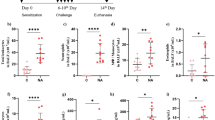Abstract
Background
This study aimed to investigate the correlation of JNK pathway-associated phosphatase (JKAP) with clinical features, inflammation, exacerbation risk, and severity in asthmatic children.
Methods
Asthmatic exacerbation children (N = 90), asthmatic remission children (N = 90), and healthy controls (N = 90) were enrolled in this case-control study, whose venous blood samples were collected after enrollment for routine blood test, JKAP, and inflammatory cytokines detection by enzyme-linked immune sorbent assay. The clinical features included demographic data, family history of asthma, and pulmonary ventilation function.
Results
JKAP level was the lowest in asthmatic exacerbation children, followed by asthmatic remission children and healthy controls. ROC curve revealed good ability of JKAP in distinguishing three groups from each other, especially in telling asthmatic exacerbation children from healthy controls (AUC: 0.926; 95%CI: 0.887–0.965). In addition, JKAP was negatively correlated with eosinophil count, immunoglobulin E (IgE), tumor necrosis factor alpha (TNF-α), interleukin-1 beta (IL-1β), interleukin-6 (IL-6), and interleukin-17 (IL-17), positively correlated with forced expiratory volume in 1 sec/forced vital capacity (FEV1/FVC) and FEV1 (%predicted) in asthmatic exacerbation children. Whereas in asthmatic remission children, JKAP was negatively correlated with eosinophil count, TNF-α, IL-1β, IL-6, and IL-17 and positively correlated with FEV1 (%predicted), but not with IgE or FEV1/FVC. In healthy controls, the correlation of JKAP with clinical features and inflammatory cytokines was non-obvious. For exacerbation severity, JKAP was the highest in mild exacerbation children, followed by moderate exacerbation children, and severe exacerbation children.
Conclusion
JKAP serves as a potential biomarker for asthmatic susceptibility, inflammation, exacerbation risk, and severity in children.




Similar content being viewed by others
References
Holgate ST, Wenzel S, Postma DS et al (2015) Asthma. Nat Rev Dis Primers 1:15025
de Benedictis FM, Attanasi M (2016) Asthma in childhood. Eur Respir Rev 25(139):41–47
Fu LS, Tsai MC (2014) Asthma exacerbation in children: a practical review. Pediatr Neonatol 55(2):83–91
Al-Shamrani A, Al-Harbi AS, Bagais K, Alenazi A, Alqwaiee M (2019) Management of asthma exacerbation in the emergency departments. Int J Pediatr Adolesc Med 6(2):61–67
Shi X, Yang W, Wang N, Zhu J (2019) Circulating JNK pathway-associated phosphatase level correlates with decreased risk, activity, inflammation level and reduced clinical response to tumor necrosis factor-alpha inhibitor in Crohn disease patients. Medicine (Baltimore) 98(33):e16622
Chuang HC, Tan TH (2019) MAP4K family kinases and DUSP family phosphatases in T-cell signaling and systemic lupus erythematosus. Cells 8(11):1433
Luchtel RA, Dasari S, Oishi N et al (2018) Molecular profiling reveals immunogenic cues in anaplastic large cell lymphomas with DUSP22 rearrangements. Blood 132(13):1386–1398
Zhou R, Chang Y, Liu J et al (2017) JNK pathway-associated phosphatase/DUSP22 suppresses CD4(+) T-cell activation and Th1/Th17-cell differentiation and negatively correlates with clinical activity in inflammatory bowel disease. Front Immunol 8:781. https://doi.org/10.3389/fimmu.2017.00781
Chuang HC, Chen YM, Hung WT et al (2016) Downregulation of the phosphatase JKAP/DUSP22 in T cells as a potential new biomarker of systemic lupus erythematosus nephritis. Oncotarget 7(36):57593–57605
Li JP, Yang CY, Chuang HC et al (2014) The phosphatase JKAP/DUSP22 inhibits T-cell receptor signalling and autoimmunity by inactivating Lck. Nat Commun 5:3618
Papadopoulos NG, Arakawa H, Carlsen KH et al (2012) International consensus on (ICON) pediatric asthma. Allergy 67(8):976–997
Ling MF, Luster AD (2016) Allergen-specific CD4(+) T cells in human asthma. Ann Am Thorac Soc 13(Suppl 1):S25–S30
Newcomb DC, Peebles RS Jr (2013) Th17-mediated inflammation in asthma. Curr Opin Immunol 25(6):755–760
Boulet LP, Turcott H, Plante S, Chakir J (2012) Airway function, inflammation and regulatory T cell function in subjects in asthma remission. Can Respir J 19(1):19–25
Funding
This study was supported by Project of Hebei Health Commission (No. 20191713).
Author information
Authors and Affiliations
Corresponding author
Ethics declarations
Competing interests
The authors declare that they have no competing interests.
Ethical approval
This study was approved by Institutional Review Board of our hospital, and all guardians of participants provided written informed consents before enrollment.
Additional information
Publisher’s note
Springer Nature remains neutral with regard to jurisdictional claims in published maps and institutional affiliations.
Rights and permissions
About this article
Cite this article
Han, H., Lu, J., Chen, C. et al. Reduced JKAP correlates with advanced disease features, inflammation, as well as increased exacerbation risk and severity in asthmatic children. Ir J Med Sci 190, 1079–1085 (2021). https://doi.org/10.1007/s11845-020-02422-0
Received:
Accepted:
Published:
Issue Date:
DOI: https://doi.org/10.1007/s11845-020-02422-0




